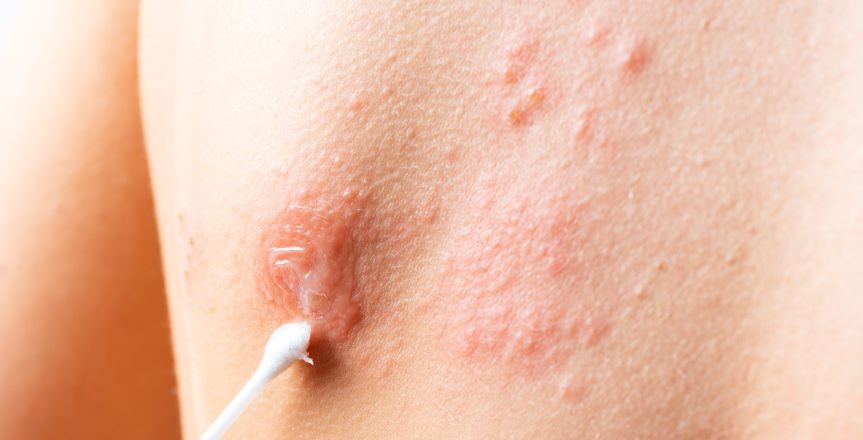Published - Thu, 29 Sep 2022

Herpes zoster (shingles)
Herpes zoster is the reactivation of the varicella virus (chickenpox) along one or two contiguous dermatomes. The prevalence of this illness is highest in elderly patients, and immunosuppression is a contributing factor (which occurs with chemotherapy, leukemia, Hodgkin lymphoma, and other malignancies).
CLINICAL FEATURES
1. Pain, burning, and hyperesthesia precede the eruption of vesicles.
2. Lesions occur on the face, neck, thorax, lumbosacral area, and the tip of the nose. The eruption is limited to one side of the body in most cases.
a) Ramsay Hunt syndrome involves cranial nerve VII; vesicles are seen in the ear canal or on the pinna. This syndrome can lead to hearing loss, facial paralysis, and loss of taste in the anterior two-thirds of the tongue.
b) Serious ocular complications can result from the involvement of the trigeminal nerve; lesions are seen on the tip of the nose. Fluorescein stain with slit-lamp eye examination may reveal a dendritic pattern consistent with a serious viral infection of the cornea.
DIFFERENTIAL DIAGNOSES
— Herpes simplex
— Poison ivy
— Contact dermatitis
— Localized bacterial infection
EVALUATION
1. For lesions involving the nose tip or peri-orbital area, the eye should be fluorescein-stained to evaluate for herpetic keratitis; consultation with an ophthalmologist is warranted.
2. A positive Tzanck smear of vesicle fluid and rising viral titers are diagnostic but seldom needed.
THERAPY
1. Acyclovir
a) Oral acyclovir (800 mg five times daily for 5 to 10 days) is effective if therapy is initiated within 48 hours of the appearance of lesions.
b) Intravenous acyclovir (10 mg/kg over 1 hour every 8 hours for 7 days) is indicated for patients with severe outbreaks, patients with herpes keratitis, and immunosuppressed patients.
c) Topical acyclovir can be applied four times daily for 10 days.
2. Prednisone can be administered orally to shorten the duration of symptoms and is given as a tapered dose, starting at 30 mg.
3. Analgesics may be needed; some patients will require opiate medications. Capsaicin cream can be applied topically five times daily and is useful for patients with postherpetic neuralgia.
DISPOSITION
Admission is required for immune-compromised patients, patients with ophthalmologic herpes zoster, and patients with complications (e.g., meningitis, peripheral neuropathy, cutaneous dissemination).
Created by
Comments (0)
Search
Popular categories
Latest blogs

All you need to know about Syphilis
Tue, 15 Nov 2022

What is Pemphigus Vulgaris?
Tue, 15 Nov 2022

Know about Scorpion Stings
Sat, 12 Nov 2022

Write a public review